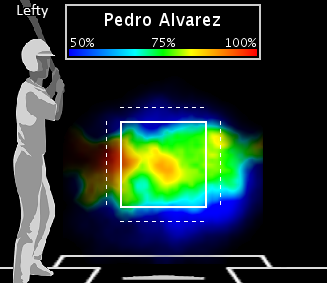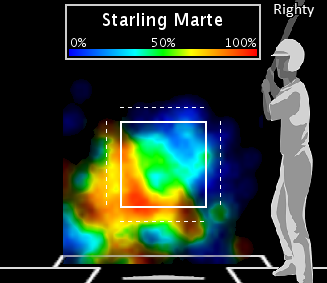Believing in Edinson Volquez
 David Golebiewski |
David Golebiewski |  Wednesday, December 18, 2013 at 6:00AM
Wednesday, December 18, 2013 at 6:00AM
Poorly as Edinson Volquez pitches, teams just keep coming back for more. It has been half a decade since Volquez vanquished hitters with premium heat and a tumbling changeup, making the All-Star team and finishing fourth in NL Rookie of the Year voting with the Reds in 2008. Since then, he has arguably been the lousiest pitcher in baseball not booted out of the rotation. Once you account for park factors and league run-scoring levels, Volquez had the worst ERA (25 percent below average) among starters tossing at least 500 innings from 2009-13.
Despite all of that aggravation -- Tommy John surgery, LaLoosh-like control, quick hooks aplenty -- Volquez continues to get opportunities. The Pirates are the latest club hoping to channel Volquez's '08 form, signing him to a one-year, $5 million free agent deal for rotation depth in case A.J. Burnett retires or refuses to take a below-market deal to remain in Pittsburgh. Let's be honest: Expecting Burnett and ending up with Volquez is kind of like asking Santa for an XBox One and instead unwrapping a Cosby sweater on Christmas morning.
Those who still believe in Volquez point out that he bears some resemblance to the Bucs' 2012 reclamation project, Francisco Liriano -- lots of strikeouts, ground ball tendencies and a fielding-independent ERA (4.24) far lower than his actual ERA (5.71), suggesting better days are ahead. Of course, Volquez could just climb the ranks of starters who continue to get the ball despite getting their heads handed to them on a regular basis (during the Expansion Era, only Jimmy Haynes and Randy Lerch have made more starts while posting a worse adjusted ERA).
If Volquez is ever going to succeed again in the majors, Pittsburgh may be the place. Pitching coach Ray Searage has helped resuscitate the careers of Liriano, Burnett and Charlie Morton. The 30-year-old righty will also benefit from working with two of the best pitch-framing catchers in the business, and a collection of rangy fielders who gobble up grounders and fly balls.
Martin, Stewart steal strikes
Volquez deserves plenty of blame for issuing 4.8 free passes per nine frames during his career, ninth-highest among Expansion Era starters throwing at least 850 innings. But it doesn't help that he also gets squeezed by umps on pitches located on the edges of the zone, and he rarely gets calls on pitches thrown a bit off the plate. Over the past three years, Volquez has a slightly lower called strike rate on pitches thrown within the strike zone (80 percent) than the MLB average (81 percent). On pitches thrown outside of the zone, Volquez has gotten called strikes just 7.7 percent of the time, well below the 9.7 percent average.
Luckily for Volquez, his new battery mates excel at getting strikes on close calls. Russell Martin has an 82.5 percent called strike rate on in-zone pitches since 2011, while backup Chris Stewart (84.3 percent) has fared even better. Both steal strikes on out-of-zone pitches, too (10.9 percent called strike rate for Martin, and 11.1 percent for Stewart). Searage and Volquez have countless video screenings and bullpen sessions ahead of them to address the pitcher's control woes, but the Bucs' catchers give them a head start.
The power of quality D
Part of the reason why Volquez underachieved last year was his .330 batting average on balls in play, fourth-highest among qualified starters and 24 points above his career average. In particular, his BABIP on fly balls (.231) was dead last among starters and over 100 points above the MLB average (.128). With Starling Marte and Andrew McCutchen chasing down fly balls in Pittsburgh (and graceful right field prospect Gregory Polanco not far away), Volquez should see fewer pitches reaching the gaps in 2015.
Collectively, Bucs pitchers had a .121 BABIP on fly balls last season. Overall, Pittsburgh converted balls put in play into outs at the fifth-best clip in the majors. By comparison, the Padres and Dodgers (Volquez's 2013 teams) ranked near the middle of the pack. Better luck and better defense should help Volquez get his ERA out of the high fives.
Volquez has some built-in advantages in Pittsburgh, though the same was said in San Diego, where he pitched in spacious Petco Park under the tutelage of Bud Black. His top-tier stuff could be waning, given that he lost a tick on his fastball (from 93.4 MPH in 2012 to 92.4 MPH in 2013) and struck out a career-low 7.5 batters per nine innings last year.
Maybe he is the second coming of Liriano, erasing years of disappointment with a dominant season. But for every Liriano, there are a dozen Kyle Davies who just never figure it out. Volquez keeps getting chances, with pitching coaches thinking he's a few mechanical tweaks away from turning back the clock to 2008. Past promise counts for less with each passing day, though. If Volquez can't make it with the Pirates, he might not get another chance.
 Dodgers,
Dodgers,  Free Agents,
Free Agents,  Padres,
Padres,  Pirates,
Pirates,  Reds | tagged
Reds | tagged  A.J. Burnett,
A.J. Burnett,  Chris Stewart,
Chris Stewart,  Cincinnati Reds,
Cincinnati Reds,  Edinson Volquez,
Edinson Volquez,  Francisco Liriano,
Francisco Liriano,  Los Angeles Dodgers,
Los Angeles Dodgers,  Pittsburgh Pirates,
Pittsburgh Pirates,  Ray Searage,
Ray Searage,  Russell Martin,
Russell Martin,  San Diego Padres,
San Diego Padres,  called strikes,
called strikes,  pitch framing
pitch framing


